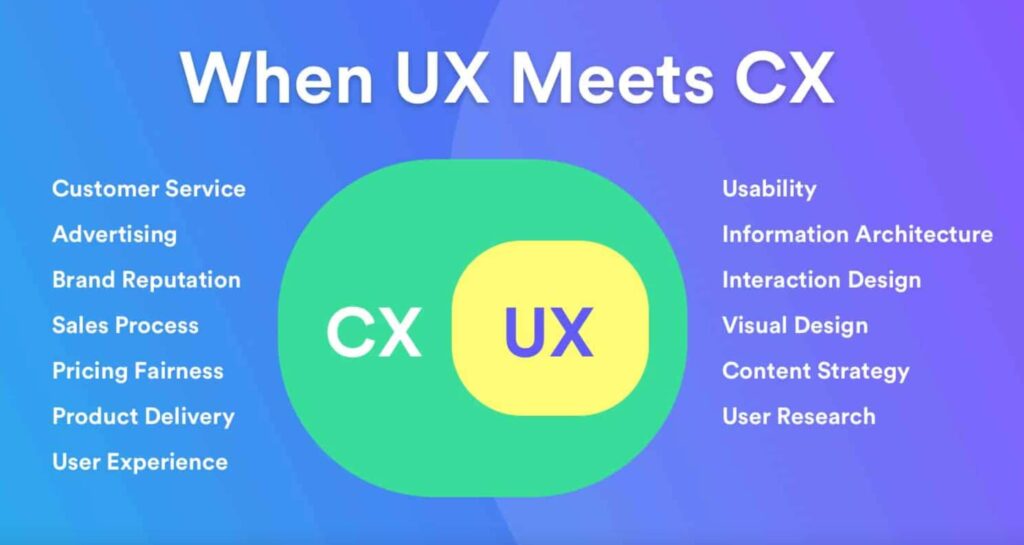Introduction
In the rapidly evolving landscape of technology and design, the convergence of User Experience (UX) and Customer Experience (CX) has emerged as a pivotal force shaping modern product design. Traditionally treated as separate entities, UX and CX are now recognized as interconnected elements that, when harmonized, create a holistic and seamless user journey. This paradigm shift is redefining the way designers approach product development, placing a premium on user-centric innovation. In this article, we delve into the significance of the convergence of UX and CX in contemporary product design, exploring how this synergy enhances overall user satisfaction and business success.
Understanding UX and CX
Before delving into their convergence, it’s crucial to comprehend the distinct roles of UX and CX. User Experience (UX) primarily focuses on the interaction between a user and a product or service, emphasizing usability, accessibility, and overall satisfaction. It delves into the design, functionality, and accessibility of a specific product, ensuring that users can effortlessly navigate and interact with it.

On the other hand, Customer Experience (CX) encompasses the entire journey a customer undergoes with a brand, from the initial awareness stage to post-purchase support. CX involves every touchpoint a customer has with a company, including marketing, sales, customer service, and beyond. Its goal is to create positive emotions and a lasting impression that fosters customer loyalty and advocacy.
The Overlapping Sphere of Influence
While UX and CX have distinct focal points, the lines between them are increasingly blurring. Modern consumers don’t view products and services in isolation; they perceive them within the broader context of their overall experience with a brand. As a result, the convergence of UX and CX becomes imperative for companies aiming to deliver a cohesive and satisfying user journey.
The collaborative relationship between UX and CX is evident in various touchpoints throughout the customer journey. For instance, a user’s interaction with a website, app, or physical product is a direct reflection of the UX, but it also contributes significantly to the overall CX. Conversely, positive experiences throughout the customer journey contribute to the user’s overall satisfaction, influencing their perception of the product itself.
The Synergy in Practice
The seamless convergence of UX and CX is not just a theoretical concept; it is actively reshaping how designers approach product development. Here are key ways in which this synergy is being implemented in modern product design:
- Unified Design Language : The convergence of UX and CX necessitates a unified design language that ensures consistency across all touchpoints. Whether a user is navigating a website, interacting with a mobile app, or engaging with customer support, the design elements, visual aesthetics, and interactive features should remain cohesive. This cohesive design language not only enhances usability but also reinforces the brand identity, contributing to a positive overall experience.
- Personalization at Scale: By combining insights from UX and CX, designers can create personalized experiences that cater to individual user preferences and expectations. This personalization extends beyond the product interface to include tailored marketing messages, targeted promotions, and customized customer support interactions. The result is a more engaging and relevant experience that resonates with users on a personal level, fostering a stronger connection with the brand.
- Seamless Omnichannel Experiences: The convergence of UX and CX is particularly evident in the development of omnichannel experiences. Modern consumers seamlessly transition between various channels, expecting a consistent and coherent experience regardless of whether they are interacting with a brand through a website, mobile app, social media, or in-person. Designing products with a holistic view of the customer journey ensures that each touchpoint contributes positively to the overall experience, reinforcing brand loyalty.
- User-Centric Data Analysis: The integration of UX and CX involves leveraging data analytics to gain insights into user behavior, preferences, and pain points. Analyzing this data allows designers to make informed decisions that enhance both the immediate user interaction (UX) and the broader customer journey (CX). By understanding how users interact with a product and their overall journey with the brand, designers can make data-driven improvements that positively impact both aspects of the experience.
- Feedback Loops for Continuous Improvement: The convergence of UX and CX emphasizes the importance of feedback loops throughout the entire product lifecycle. Collecting user feedback not only helps in refining the immediate user experience but also provides valuable insights into the overall customer satisfaction. This iterative process of improvement ensures that products evolve to meet the changing needs and expectations of users, contributing to sustained customer loyalty.
Benefits and Business Impact
The convergence of UX and CX is not merely a design philosophy; it has tangible benefits that directly impact business success. Here are some key advantages:
- Enhanced User Satisfaction: By addressing both the immediate user interaction and the broader customer journey, the convergence of UX and CX creates a more satisfying and enjoyable experience for users. This heightened satisfaction leads to increased brand loyalty and positive word-of-mouth, driving customer retention and acquisition.
- Improved Customer Loyalty: A seamless and positive customer journey fosters loyalty. When users consistently encounter a brand that understands their needs, provides relevant solutions, and values their overall experience, they are more likely to remain loyal customers. This loyalty translates into repeat business and a higher customer lifetime value.
- Competitive Advantage: In a competitive market, where products and services may offer similar features, the overall experience becomes a crucial differentiator. Companies that successfully converge UX and CX gain a competitive edge by delivering a comprehensive and superior user journey. This distinction can be a deciding factor for consumers when choosing between competing products or services.
- Increased Revenue Streams: Satisfied and loyal customers are more likely to explore additional offerings from a brand. The convergence of UX and CX enables companies to cross-promote products and services seamlessly, expanding revenue streams. Moreover, positive experiences often lead to upsells, as customers are more receptive to exploring premium offerings or additional features.
Challenges and Considerations
While the convergence of UX and CX brings numerous benefits, it also presents challenges that designers and businesses must navigate. Some key considerations include:
- Consistent Communication: Achieving a seamless convergence requires consistent communication and collaboration between UX and CX teams. Siloed approaches can lead to disjointed experiences, undermining the effectiveness of the convergence. Open communication channels, shared goals, and a collaborative mindset are essential for success.
- Balancing Personalization and Privacy: Personalizing user experiences is a powerful strategy, but it must be balanced with respect for user privacy. Designers must navigate the delicate balance between delivering tailored experiences and ensuring the responsible use of user data to maintain trust.
- Adaptability to Changing User Expectations: User expectations evolve, and successful convergence requires adaptability. Designers must stay attuned to emerging trends, technological advancements, and shifts in user behavior to proactively adjust their strategies and designs.
Conclusion
The convergence of UX and CX in modern product design represents a paradigm shift that acknowledges the interconnectedness of user interactions and overall customer experiences. By treating UX and CX as complementary elements, designers can create products that not only meet users’ immediate needs but also contribute to a positive and memorable overall journey with the brand. The synergy between UX and CX is not just a design philosophy; it is a strategic approach that enhances user satisfaction, fosters loyalty, and ultimately drives business success in the dynamic landscape of modern technology and consumer expectations. As businesses embrace this holistic approach, they position themselves at the forefront of innovation, ensuring sustained customer loyalty, a competitive edge, and thriving revenue streams in today’s dynamic market.

